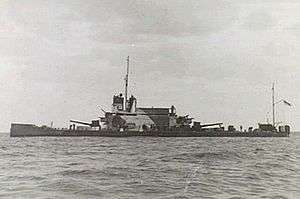HMS Ladybird (1916)
 HMS Ladybird at Port Said in November 1917 | |
| History | |
|---|---|
| Name: | HMS Ladybird |
| Launched: | 1916 |
| Fate: | Sunk in shallow water 12 May 1941, used as anti-aircraft position. |
| General characteristics | |
| Class and type: | Insect-class gunboat |
HMS Ladybird was an Insect-class gunboat of the Royal Navy, launched in 1916. This class are also referred to as "large China gunboats". Originally built to patrol the River Danube during World War I, she sailed for China from Malta in February 1927 to serve on the Yangtze River.
History
On 12 December 1937, Ladybird, along with Bee became involved in the Panay incident and came under fire from a Japanese artillery unit near Wuhu on the Yangtze River. Ladybird was hit by six shells and Bee dodged a shell as she came upon the scene, however Ladybird did not take enough damage to put her out of commission, and both Ladybird and Bee helped pick up survivors from the sunk USS Panay.
In 1939 the original pair of 6-inch (152 mm) Mk VII 45-calibre guns were replaced by more modern and 30 inches (760 mm) longer 6-inch Mk XIII 50-calibre guns from the decommissioned battleship HMS Agincourt.
Ladybird was allocated to Singapore in 1940 and then, along with five others of the class, stripped down and towed to the Mediterranean Sea. During the journey she sustained damage which meant she was limited to a speed of 7 knots (13 km/h; 8.1 mph) due to a misaligned hull. She was initially used to guard Port Said.


In late December 1940 and early January 1941 Ladybird was engaged at close range in bombarding the Italian port of Bardia in Libya, in preparation and support of the Allied assault and capture of Bardia on 5 January 1941 as part of Operation Compass.
On 25 February 1941 she landed a Royal Marines unit during Operation Abstention, an ill-fated attempt to seize the Italian island of Kastelorizo, where she was hit by an aerial bomb. Later, acting in support of the Tobruk garrison, she shelled the Gazala airfield and ferried in supplies. During this duty, on 12 May 1941, she was severely damaged by dive bombers and set on fire, settling on an even keel in 10 feet (3.0 m) of water. Still above water, her 3-inch (76 mm) gun was used in an anti-aircraft role. HMS Gnat then replaced Ladybird in supporting Tobruk.
External links
| Wikimedia Commons has media related to HMS Ladybird (ship, 1916). |
Coordinates: 32°4′33″N 23°58′21″E / 32.07583°N 23.97250°E